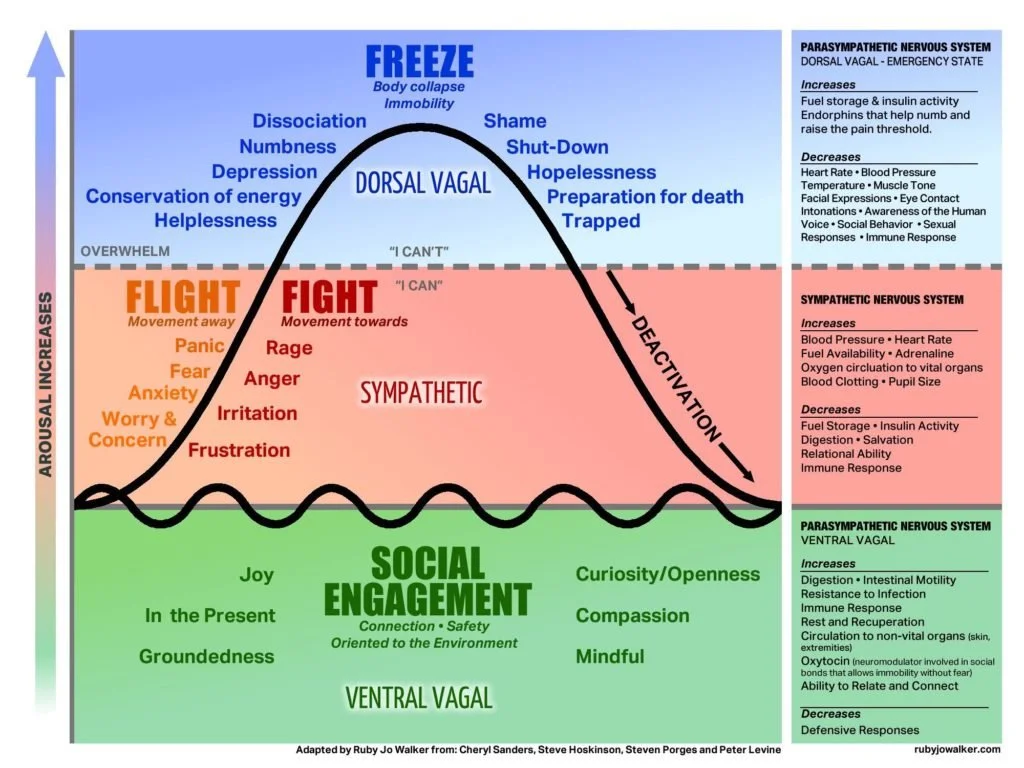Polyvegal Theory
Have you ever felt calm and in control one moment, then overwhelmed or shut down the next? These shifts are often rooted in how your nervous system responds to stress—and the good news is, you can build your capacity to handle it.
Polyvagal Theory: Your Body’s Safety System
Polyvagal Theory, developed by Dr. Stephen Porges, explains how our nervous system responds to cues of safety and threat. It highlights three core states:
Safe & Social (Ventral Vagal) – You feel connected, curious, and grounded.
Fight or Flight (Sympathetic) – You feel anxious, angry, or on edge.
Freeze or Shutdown (Dorsal Vagal) – You feel numb, withdrawn, or overwhelmed.
Some also experience Fawn, a learned survival response where we prioritize others' needs to avoid conflict or rejection.
These responses are automatic, protective strategies your body uses to help you survive. But with awareness and support, you can shift out of survival mode and back into connection.
The Window of Tolerance
Your window of tolerance is the space where you feel regulated, resilient, and able to engage with life—even under stress. When you're outside of it, survival responses take over, and it becomes hard to think clearly or feel safe.
The good news: your window can grow. With time and intention, you can widen your capacity for stress and increase your access to calm, presence, and connection.
Protective Factors Build the Window
Protective factors are the internal and external supports that strengthen your nervous system. They build and reinforce your window of tolerance, making it easier to bounce back from stress and stay grounded in daily life.
Protective factors include:
Supportive relationships: Co-regulation helps soothe and stabilize your nervous system.
Mindfulness and grounding: Presence helps you notice when you're outside your window—and how to return.
Movement and rest: Physical rhythms (like exercise and sleep) help regulate your internal state.
Purpose and meaning: Feeling connected to something larger builds psychological resilience.
Boundaries and self-awareness: These help prevent overwhelm and emotional flooding.
Self-compassion: Kindness toward yourself softens reactivity and fosters flexibility.
Decompression Strategies by Nervous System Response
Everyone responds to stress differently. Here are simple, body-based strategies to help you decompress and regulate, depending on how your system is reacting:
Fight – When you feel angry, reactive, or defensive
Try:
Fast-paced movement (like boxing, jogging, or dancing) to release energy
Breathing out longer than you breathe in (e.g., 4 in, 6 out)
Cooling down with water (splash your face or take a shower)
Journaling to express frustration safely
Goal: Channel energy and restore calm without suppressing emotion.
Flight – When you feel anxious, restless, or panicky
Try:
Rhythmic movement like walking, pacing, or biking
Orienting: Look around and name five things you see
Safe distraction: puzzles, games, organizing a small space
Weighted blankets or firm pressure to bring you back to your body
Goal: Slow the pace and remind the body it’s safe to be still.
Freeze – When you feel numb, shut down, or disconnected
Try:
Gentle movement like stretching, rocking, or tapping your arms
Warmth—wrap in a blanket or drink something hot
Listening to rhythmic, low-toned music
Naming something you’re grateful for or visualizing a safe place
Goal: Invite small signals of safety to awaken and re-engage your system.
Fawn – When you feel overly accommodating, people-pleasing, or invisible
Try:
Practice saying “no” in low-stakes situations
Check in: “What do I need right now?”
Write a boundary or affirmation statement (e.g., “My needs matter too”)
Reconnect with self: journal, create, or spend time alone mindfully
Goal: Reclaim agency, self-awareness, and emotional space.
You Can Build This Capacity
With practice and the right support, you can learn to notice your nervous system’s signals, regulate in real time, and return to a more grounded, open state. Your nervous system is not broken—it’s doing its best to protect you. But you can teach it new ways to feel safe.
